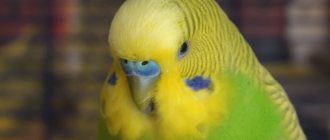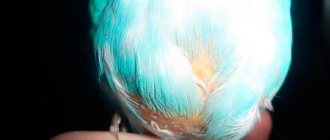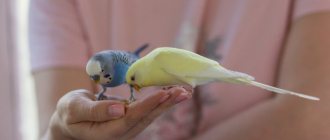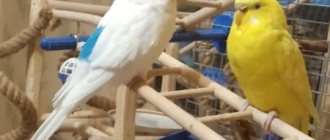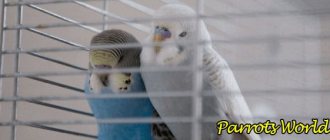Budgerigars are tiny bright birds with funny habits and good-natured character. Under favorable conditions, they can reproduce in captivity and take care of their offspring independently. And although their breeding seems to be a simple and not troublesome task, there are a number of nuances in it.
Let's find out how budgerigars reproduce at home and what difficulties may arise in the process.
Preparing for parrot mating
Wavys are a prolific variety. Parrots breed three times a year. But to obtain strong and healthy chicks, such situations should not be allowed. Ideally, parrot breeding should be repeated no more than 2 times a year. The optimal period for breeding is the warm season from mid-May to early September.
In order for the breeding of parrots to be successful, the birds need to create certain conditions and provide special nutrition. It is recommended to begin preparations for nesting a couple of weeks before installing the house. The bird cage should be placed in a warm, quiet and peaceful place, away from drafts and noise sources.
In the room in which parrots will breed, it is necessary to maintain the temperature within 23-26 degrees Celsius. You should also ensure that the length of daylight during the mating season is 14-16 hours.
Matching
Breeding budgies at home begins with the correct selection of breeders. To obtain strong and viable offspring, it is necessary to allow completely healthy and mature birds from different nurseries to breed.
Future parents should be active and moderately well-fed. Budgerigars that are in poor health or overweight or underweight should not be allowed to breed. Such birds often lay dummy eggs.
When making a couple, you should pay attention to the age of the potential parents. Male budgerigars can breed from 10 months, females - from 1 year. But the peak of bird fertility is observed at the age of 2-4 years.
Important! An adult female is prone to dominance and can peck at a young male. For budgerigars to begin breeding, there must be an age difference of about 2 years between partners.
When selecting a pair, it should be taken into account that the reproduction of parrots is impossible without mutual sympathy. If the female does not like her partner, she will flatly refuse to mate with him. Therefore, the birds can be allowed to choose with whom to breed - by placing a group of different-sex budgies in a spacious cage.
Arrangement of the cage and nest
Breeding parrots at home is impossible without a comfortable and properly equipped home. The cage where the birds will breed must be equipped with two doors, through which it is convenient to install the nest and do cleaning. The size of the home for a pair of budgies should be at least 60 x 30 x 40 cm.
In order for the female to have a place to lay eggs, a nesting house with a removable roof needs to be installed in the cage. It comes in three types:
- Vertical. The dimensions of such a house are 20 x 20 cm with a height of 25 cm. Thanks to the special design, the hatched chicks will not leave the nest prematurely. But due to the high entrance, the female can damage the clutch.
- Horizontal. The house measures 25 x 20 x 15 cm and has a low entrance to prevent damage to the masonry. It is inconvenient because there is a risk of chicks falling out.
- Compromise. The house measures 20 x 25 x 20 cm and is equipped with a step at the bottom to make it comfortable for the female to sit on the eggs.
On a note. To make a nesting house in which budgies will breed, it is better to use spruce, pine or birch. Cardboard, plywood and chipboard are not suitable for these purposes. They are impregnated with glue and do not retain heat.
How to properly breed budgies
The appearance of new bird life is a wonderful moment, but at the same time a very important one. If you are thinking about breeding parrots, then it is best to start this simple and at the same time difficult task with budgies.
Before hanging a nest, be sure to read the literature, since at the most crucial moment you must be prepared for any emergency situations. Remember that nesting will take several months; during this time you should not make a lot of noise, make repairs, rearrange furniture, or be away for a long time.
How to choose the right pair for breeding
The first thing you should know is choosing the right pair. Birds must be of different sexes... This may sound obvious, but often owners, without understanding the intricacies of sex determination, hang nests for same-sex birds and expect chicks from them. Birds suitable for breeding should be at least one year old. This concerns females primarily, since their reproductive system in captivity matures precisely at this age. Males may be ready a little earlier. Remember that an immature bird may have problems laying eggs and may lack parental instinct. The couple must be in good condition, without obesity or excessive thinness, healthy and moulted. The breeding process will take several months and require enormous energy expenditure on the body, so weakened birds may even die. It happened that the males fed the chicks and the female until they were completely exhausted, while they themselves ate almost nothing. Birds should not be relatives, since inbreeding can result in the appearance of weak chicks or the appearance of congenital pathologies in them.
Budgerigars are quite easy to breed at home. Also, having studied the basics of budgerigar genetics, you can choose a pair so that the chicks will turn out to be of some special color.
So, you have selected a pair, make sure that the birds are not aggressive towards each other, since nothing good will come from such breeding. You can let the birds choose a partner on their own, but at the same time, all of the above conditions must be met. If the birds do not show sympathy for each other, but are not aggressive towards their partner, you can try to move them away from the flock into a separate cage. Perhaps, after some time, a couple will form.
Budgerigars can nest at almost any time of the year; the main thing is to properly prepare the birds for this important event. Of course, in spring and late summer, when there is enough young greenery, juicy fruits and vegetables, things will go faster, but you yourself can create such conditions at any time of the year.
Preparing the cage for breeding. In addition to the parents, it must accommodate potential chicks, of which there can be up to 7 - 9 individuals. Therefore, the minimum dimensions of the cage should be 40x30x40 cm, ideally 60x30x40 cm. The larger the cage, the better. The cage should be in a well-lit place, not in a draft and away from heating devices at human eye level. This is quite high, but this way the birds will feel safer and will be more willing to breed. Remove everything unnecessary from the cage; birds should not be distracted by foreign objects. The cage must have strong and stable perches to support mating birds.
Feeding budgies during the breeding period
This is very important, since in nature the breeding season occurs at a time when the bird’s diet is rich in various feeds in order to replenish the body’s energy costs for raising chicks. At home, with a diet rich in animal protein foods, we “awaken” the reproductive system, forcing it to work correctly and fully. 2 weeks before hanging the house, you need to gradually increase daylight hours to 14 hours using artificial lighting. The room temperature should be at least 15 degrees. It should not be very hot, since at high temperatures the embryos in the eggs may die.
In addition to light, diet is no less important. One grain mixture will not be enough. Animal proteins must be included in the diet. Most often it is a mixture of boiled chicken or quail egg, carrots and crackers. However, in order not to overly burden the internal organs of the parrots with this food, it is better to give this mixture every other day. It is also necessary to include sprouted grains in the diet; they are very rich in vitamins and microelements, so necessary during this period. It is necessary to germinate cereals and other seeds before the grain pecks, because when the greenery begins to appear, all the beneficial substances begin to grow and there are already few useful substances in the seed itself. When sprouting, be careful not to give sour grain or moldy grain to the birds. This may cause digestive upset or poisoning. The cage must have sources of calcium - chalk, sepia, mineral mixture. If birds ignore them, sprinkle these mixtures on wet food or add liquid calcium gluconate to them. Don't forget about the permitted fruits, vegetables, berries and herbs.
Preparing the nesting site
When all conditions are met, you can hang the house. It must be prepared in advance. We hang the house from the outside at the top of the cage, leaning it against the second door. The house can be horizontal with dimensions of 25x20x15 cm, vertical 20x20x25 cm or a compromise 22x20x20 cm, with a 4.5 cm entrance. The lid on top should be removable for cleaning and easy control of the clutches and chicks. Don't forget about the ventilation holes.
You can buy a house or make it yourself using materials that are non-toxic to birds. The house should have a nesting hole so that the eggs always remain in one place. There should also be a perch outside. The house should not be very heavy, since it will need to be hung on the cage. Some hobbyists use natural nest boxes, but remember that the wood may contain parasites that are dangerous for parrots and their chicks. The nest box needs to be well handled, it is heavy and sometimes it is simply impossible to hang it on the cage, and it is also difficult to control what is happening inside it. We pour sawdust or shavings of deciduous trees into the house. The sawdust must be clean. You can add chamomile to the sawdust; it will repel parasites and help maintain a healthy microclimate in the nest. If the female has raked out all the sawdust from the nest in the first stages, you can add more to it. However, some females lay eggs on completely bare floors.
Laying eggs
The female budgerigar lays her first egg approximately 10 days after mating. Sometimes one mating is enough to fertilize the entire clutch. Before laying an egg, the female can sit with her tail lowered, shaking it slightly; the litter can double in size. Carefully monitor the condition of the female during this period; laying the first egg can become problematic for some females, sometimes they require human help.
Then 1 egg is added per day, sometimes every other day, until there are from 4 to 8 eggs in the clutch. The female may begin incubation not from the first egg, but from the second, and sometimes from the third egg. Don’t worry, because until the female begins to incubate them, the embryos will not begin to develop and a chick will also hatch from the first egg. Only the female incubates the chicks, while the male forages for food and regurgitates food for the female.
After the first egg is laid, we stop giving protein food, leaving the grain mixture, sprouted grains, fruits and vegetables. It is also better to limit greens, as they can weaken you.
The appearance of chicks
On the 18th day of incubation, chicks are born. A quiet squeak will notify you of this significant event. The chicks hatch approximately every 2 days, blind, naked and completely helpless. All this time, the female warms the babies and almost never leaves the nest. Chicks gain weight very quickly.
After the first chick appears, we return protein food to the diet. After the chicks are born, for a total of up to two weeks, the female feeds the chicks with crop milk. Older chicks already receive grain and protein feed.
The first cleaning of the nest is done depending on the number of chicks and the nervous state of the female. You should seize the moment when the female leaves the nest to block her possibility of returning. Carefully transfer the chicks into a container with sawdust, quickly, so as not to disturb the female more than necessary, carry out mechanical cleaning of the house. Add fresh sawdust and return the chicks to their place. Next cleaning as the nesting area becomes dirty. During cleaning, it is necessary to inspect the paws of the chicks. If droppings stick to them, they need to be soaked in a small amount of water to prevent deformation of the feet.
As soon as the strong chicks are able to feed on their own and leave the house, the female has a desire to quickly have new children, and sometimes she begins to mercilessly peck at the “older ones.” So it is better to plant young parrots. They usually leave the house 28 - 35 days after birth. Until about 38-42 days they are still fed by the male, but then they become completely independent.
Young chicks are fed the same food as their parents during the breeding season for several weeks and care is taken to ensure that they feed themselves adequately. If you follow all these rules, your couple will soon delight you with the quiet squeak of chicks from the nest. Don't be discouraged if the female doesn't go to the nest right away, sometimes it can take more than a month. Sometimes an inexperienced male is not always able to fertilize a female, be more patient with the birds, give them a chance. If all else fails, try again after a few months or replace the birds with partners, since partner incompatibility and infertility also occur in budgerigars.
The female can be allowed into the second clutch, provided that there were no more than 5 chicks in the first and the bird is in good shape.
As a rule, the second brood appears much earlier than the first, since the birds do not need time to “build up” their body, everything is already set up. If there were a lot of chicks, then the birds need rest for at least six months.
What to do if egg laying is delayed, read here
Feeding during the breeding season
In order for budgies to reproduce and raise offspring, they need a special diet. During this period, in addition to the usual grain mixtures, fruits and vegetables, it is advisable to give birds a lot of dandelion leaves, plantain and other fresh greens.
For normal formation of eggs, the diet of birds should be enriched with unleavened cereals and calcium-containing products such as low-fat cottage cheese and crushed shells.
When budgies begin to reproduce, it is beneficial to give them sprouted grains and vitamin and mineral supplements. Soft mash, which can be different in composition, will also not be superfluous:
- wheat sprouts, broccoli, low-fat cottage cheese and pumpkin;
- steamed cereals, eggs, herbs, carrots and zucchini;
- hamarus, sprouted grains and bell peppers;
- greens, boiled egg, pearl barley, a mixture of boiled oats and millet;
- eggs, grated beets, oats, millet and lentil grains;
- greens, boiled egg, apples, carrots and rice porridge.
When budgies begin to lay eggs, soft foods are removed from their menu and replaced with grains. 1-2 days before the birth of the offspring, the expectant mother is again given eggs, sprouted grains and vegetables with a high content of carotene.
Additional terms
Conditions for breeding
Before breeding parrots in captivity, three conditions must be met.
- Daylight hours should be long. For most species during the nesting period it is about 15 hours. Its duration should be increased gradually, adding an hour and a half for ten days.
- Properly formulated diet. In the wild, an abundance of food is a sign of the most favorable time for reproduction, a signal for the beginning of the mating season. Therefore, pets need a varied diet with sufficient vitamins and minerals.
- "Nesting landscape". Without a device that replaces a natural hollow, it will not be possible to breed parrots in captivity.
Conditions for breeding parrots
Depending on the breed, additional conditions may be required. Thus, to breed medium-sized parrots, you need an aviary, preferably located in the open air, and some species of birds also require increased air humidity and a source of artificial lighting.
Parrot diet
During the period of incubation of eggs and nursing of chicks, new parents need to be fed. After about two weeks, an egg-carrot mixture and cottage cheese are added to the diet. Many breeders give their female dogs a roll soaked in milk. It is an additional source of calcium and energy. During the laying period, birds need to consume more greens, sprouted grains, vegetables and fruits.
Read also
Rio food for budgies reviews
Nesting
Before they begin to reproduce, parrots look closely at each other. If they don’t fight, they play, then you can expect a replenishment soon. The male begins to court the female. He chirps loudly, takes various poses, cleans his partner’s feathers and brings her food.
You can tell that a female is ready to breed by her behavior. She tries to constantly be close to the male and responds to his advances. Parrots usually reproduce unnoticed by their owners.
If mating was successful, then after a few days the female will begin to build a nest. First, she will examine the house from all sides, and then she will begin to restore order in it. She builds a nest from dry grass, sawdust and thin twigs.
Disinfection
Be sure to disinfect all items you will need during this time. The cage, drinkers, feeders and toys are soaked in hot water with a weak bleach solution, and then rinsed thoroughly. The house itself is disassembled, cleaned with baby soap, dried, then calcined in the oven at 120 degrees for 30-40 minutes, some, after a good bath of the nest, calcine it on a gas burner until the outer wall becomes hot - it all depends on how and what it is made of.
It would be a good idea to add dry medicinal chamomile to the sawdust that you will add to the nest - it prevents the appearance of gamas mites.
The appearance of offspring
The chicks hatch 18 days after the last egg appears. They break the shell and get out. The female helps them free and sometimes eats the shell.
Babies are born naked and blind, and their weight is only 1-2 g. At first, the chicks constantly lie down and do not hold their heads up. During the first days they feed on crop milk, which the mother releases into their beak.
Important! Budgerigar chicks do not hatch at the same time and grow very quickly. By the time the last cub appears, the first ones become quite large and can injure the baby. To prevent this from happening, the breeder should check the nest frequently.
How does courtship work in parrots?
The mating season for budgerigars is a very interesting time. The male constantly looks after his soul mate - feeds her, cleans her, constantly dances around and sings, tries with all his might to show his beauty. In response, the female constantly clings to her partner and squints her eyes. Birds have sex in the following way: the female sits lower, and the male climbs on top and begins the act of intercourse.
Difficulties of breeding parrots
Breeding budgies at home is not always successful. The most common difficulties that often become a problem for beginning breeders:
- Parrots don't mate. The reason that the wavy birds do not reproduce may be that the birds are too young or old, poor nutrition, health problems or unsuitable living conditions.
- The female carries eggs without a male. This is due to the instinctive desire to reproduce. Don't worry if the female manages to lay an egg without a male once. If a day later the next one appears in the nest, then they need to be removed from the cage. True, it is better to do this not immediately, but after a few days. After all, if a female parrot lays an egg without a male, then the bird satisfies its natural instincts. And we must make sure that she does not lose the desire to reproduce in the future.
- The male parrot laid an egg. This situation arises due to the fact that an error was made when initially determining the sex of the bird. There is not a male in the cage, as was initially assumed, but a female.
- The appearance of unfertilized eggs. The absence of embryos inside the shell can be caused by an unwillingness to reproduce, uneven heating of the clutch, the presence of genetic diseases, poor nutrition, infections and an unsuitable microclimate.
- Egg stuck. This problem occurs in those females who “give birth” too often. If the birds are not provided with timely qualified assistance, they will die.
Bird behavior
A separate cage is allocated for meeting couples and breeding at home. If the birds behave non-aggressively and communicate with each other, then mating can be expected in the near future. The male's courtship is manifested in the following ways: flapping his wings, special songs, feeding the female and cleaning her feathers. If the female accepts courtship, she nods her head and “kisses” the male’s beak.
Sometimes pairs do not work out, parrots do not mate. Females may not pay attention to partners or show aggression. In such cases, ornithologists advise choosing another, calmer male for the female.
What birds can be allowed to breed?
Females over 12 months old and males over 10 months old are usually allowed to breed. Birds should not be from the same breeder, as there is a high probability of being closely related. In this case, the chicks may have congenital defects. It is also prohibited to use sick, obese and elderly parrots for breeding. They are prone to tumors, have difficulty laying eggs and do not lay eggs well. It is also not recommended to breed birds during the molting period. Their body needs additional substances to renew their plumage, so laying may not occur at all, or may be accompanied by various complications. Ideally, budgerigars taken for breeding should be energetic and attentive to each other. It is advisable that parrots make attempts to mate.
Nutrition
To obtain all the microelements necessary for reproduction, parrots need to be given mineral supplements during reproduction. She should always lie in a tray in a cage. Chalk is perfect for calcium. It can be crushed and added little by little to the soaked grain.
The success of breeding directly depends on the nutrition that the birds receive:
- Sprouted soaked grain directly affects the bird's sexual instinct.
- Kefir, vegetables and cereals affect the production of normal eggs.
- You can also please your feathered pets with a simple salad made from just four ingredients - cottage cheese, sprouted grains, chopped hard-boiled egg and grated carrots. It is enough to feed them this dish twice a week.
After the female lays eggs, you need to stop feeding her soft food, replacing it with additional portions of seeds and sprouted grains. You also need to carefully monitor the water - it should always be clean. Dirty water can make you sick.
Mating season
Most often, females accept courtship from older partners. Males begin to conquer only when they have acquired a cozy nest. This should be understood if you want to know how long to wait for the first eggs.
How to understand that a male is ready for a family
During the mating season, the male takes the initiative. To understand that he is ready for family life, watch him. The feathered one will devote all his strength and time (no matter how much is required) to conquering his chosen one.
The parrot chirps, playfully taps its beak, jumps around, feeds the female, and presents a variety of gifts. Why is he doing this? Draws attention to itself.
Demonstrating readiness for motherhood
The fact that the female is ready for motherhood is signaled by the brown color of the small skin growth on the beak. When the chosen one is ready, she will accept courtship. After watching the video, you can see how the formed couple behaves.
The female will begin to tuck her wings and raise her tail feathers, fluffing out the feathers on her head, a few days after courtship begins.
How does mating happen?
Feathered pets do not have external genitalia. Reproduction of budgerigars occurs due to the contact of cloaca.
Females have an ovary and an oviduct, which opens into the cloaca. Males have several testes with canals, which also exit into the cloaca. Feathered pets reproduce as follows: the pair is positioned so that the female is on the bottom. The male will need to press closer to the area under the tail.
During reproduction, mating occurs repeatedly. The process of creating a family can begin a few days after hanging the nesting house. Sometimes situations occur when a couple that has already been formed for a long time begins to reproduce without waiting for construction.
Business relevance
Parrots are very beautiful, living birds. Some of them can repeat simple words and phrases, copy the sounds of other birds and animals. Males are especially capable of this.
Many people want to have parrots. After all, the desire to take care of our little brothers is inherent in human nature. But in a multi-storey building, not everyone can afford to have a dog or cat. It is easier to keep a parrot, and there is a lot of joy from it.
They multiply quickly, are small, and are easy to keep.
Therefore, the parrot breeding business will certainly be successful.
Courtship of a female
The active phase of courtship begins immediately after choosing a suitable partner for reproduction. The male is constantly next to his chosen one, constantly cleaning himself and feeding his passion. Periodically covers her with his wing, looks into her eyes and nods. The parrot also dances next to the object of its love, periodically knocking its beaks on objects nearby.
If the female develops mutual sympathy, she dances with her partner and also kisses him. Some begin to become so lazy that they only consume food from males. Such games can last from several days to several weeks. One fertilization is often enough for the appearance of offspring, the next stage is incubation of the chicks.
Caring for chicks
Parrots are born small - they weigh only a couple of grams, and there is no plumage. It is difficult for them to hold their head up or sit on their own; for this reason, the chicks constantly lie down. At the same time, mother parrots are very caring - they independently feed the chicks who cannot sit.
The chicks grow very quickly - their size doubles in a day (weight and length). Since the cubs emerge from the eggs on different days, its older brothers and sisters can be much larger than the youngest in the family. Therefore, you need to carefully monitor the tub, checking the condition of the birds every day.
At this stage, many who want to start a parrot business understand that it is better to try themselves in another field.
When can you plant
Parrots watch their children for more than a month. During this time, small parrots acquire dense fluff, and they already know how to feed on their own. Flight attempts also occur periodically. At first they are unsuccessful, but after a while everything starts to work out. Five days after the first flight, the young generation can be separated from their parents in different cages.
Premises requirements
It should be spacious and warm. This could be a shed with windows, a heated garage, an attic or a purpose built building. They create conditions for the birds that are close to natural in temperature and light. Indoor humidity is about 70%.
Parrots can live in fairly cold rooms, but there should not be sudden temperature changes. Some species can withstand frost up to 10 degrees. Drafts have a detrimental effect on them.
Some medium (wavy) ones can reproduce in small cells.
New Zealand kakariki breed only in an aviary. One enclosure is needed per couple at this time. There should be no holes in it that he instantly finds.
The enclosure where Rosella lives must be at least 4 m long, because it loves to fly.
Song parrots are unpretentious to conditions. Their maintenance and breeding differs in that only one pair can be kept in one room. Otherwise they will fight.
Large parrots are bred in enclosures.
To breed Alexandrine parrots, you need an aviary with a side of at least 2 m.
Provides for daily cleaning of the premises.
Sales market: where to sell parrots
For sale, it is important to have a conclusion from a veterinarian that the chicks are free of diseases.
Main selling methods:
- Zoological shops. You can sell 10-20 individuals there at once, but the price will be lower than you can get on your own.
- Word of mouth. Write to your friends: perhaps they know who can buy a parrot chick.
- Independent sale through thematic forums and message boards.
- Independent selling through social networks.
